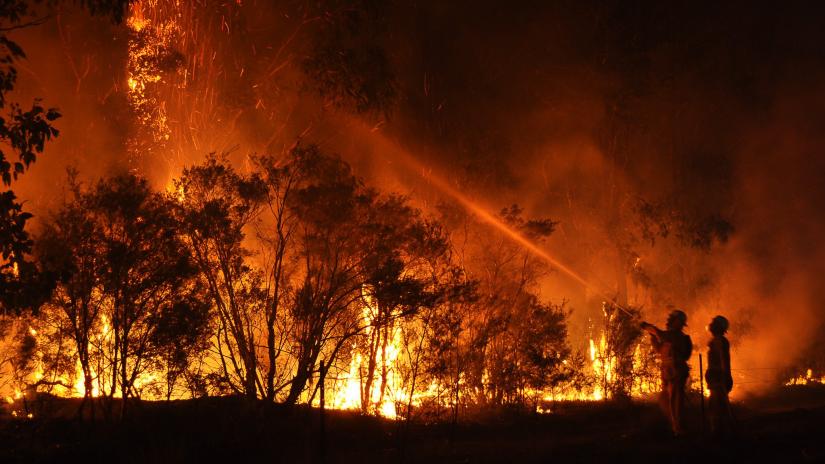A new study asked more than 470 NSW firefighters how they recover in the field, especially in situations of greatest heat stress.

Firefighters respond to a bushfire in Cessnock. Image: Quarrie Photography / Flickr (CC BY-NC-ND 2.0)
Searing heat, fireballs and walls of embers. Firefighters faced extreme conditions during the 2020 summer bushfires, which claimed the lives of nine firefighters across Australia. Now research is drawing on sport performance strategies to better help them combat heat stress and fatigue.
A new study asked more than 470 NSW firefighters how they recover in the field, especially in situations of greatest heat stress. Air and helmet temperatures at residential fires can reach 750C and 190C respectively, while flame temperatures during bushfires can be as high as 1100C.
The study found firefighters generally rely on simple strategies to lower their core body temperature, such as finding shade, drinking water and removing helmets and jackets. However, the research suggests there is potential for better cooling and recovery protocols.
Dr Hugh Fullagar from the Human Performance Research Centre at the University of Technology Sydney (UTS) led the study, which was conducted in partnership with Fire and Rescue NSW – the fourth largest urban fire service in the world.
“NSW’s 7000 firefighters are tasked with protecting the homes and lives of 8 million people from the perils of fire. They have to perform physical tasks in extreme heat while wearing heavily insulated protective clothing, which results in acute physical and psychological fatigue.
“We know from data overseas that more than 75 per cent of firefighters experience heat-related illness symptoms such as headache, sudden muscle cramps, dizziness, nausea, and fainting, and that sudden cardiac death accounts for almost half of all firefighter duty-related fatalities.
"Heat stress also results in poorer cognitive functioning and decision making, which in turn likely increases the risk of fatalities,” Dr Fullagar said.

Fire and Rescue NSW firefighters work to save a burning house in an out of control bushfire in December 2019. Image: Wikimedia
Despite these risks, there has been limited understanding of how firefighters perceive the challenging tasks they perform, the conditions they face, or the fatigue and recovery strategies required to optimise performance and health during active duty.
“Given the predicted increased prevalence of bushfires in Australia due to climate change, along with the unique conditions, terrains and duties our firefighters face - which pose risks to operational safety - it is important to identify more effective, yet practical cooling strategies to recover from physically and mentally demanding tasks in the heat,” Dr Fullagar said.
“We need to understand how firefighters are feeling, what they like or dislike and what is available to them to help optimise cooling and safety, if we want to improve best-practice.”
While the firefighters surveyed generally used simple cooling strategies such as sitting in the shade, drinking water or removing protective clothing, it is thought this is mainly due to what is available.
They expressed a desire for improved access to similar methods being applied to promote safety and performance in sport such as cold consumables (eg. slushies), external cooling aids (eg. ice packs/vests), as well as other recovery equipment (eg. cooling fans, portable shade cover).
This study was the first part of a two-part study. With a better understanding of the available and relevant cooling and recovery strategies preferred by firefighters, the next step is to determine the optimum combination, timing and selection of these strategies.
This will be assessed in a controlled, laboratory environment to help establish ‘best practice’ recovery protocols following fire-fighting activity. The identification of these protocols will help firefighters recover, as well as enhance the safety of the workforce.
The study: Australian firefighters perceptions of heat stress, fatigue and recovery practices during fire-fighting tasks in extreme environments, was recently published in the journal Applied Ergonomics.

